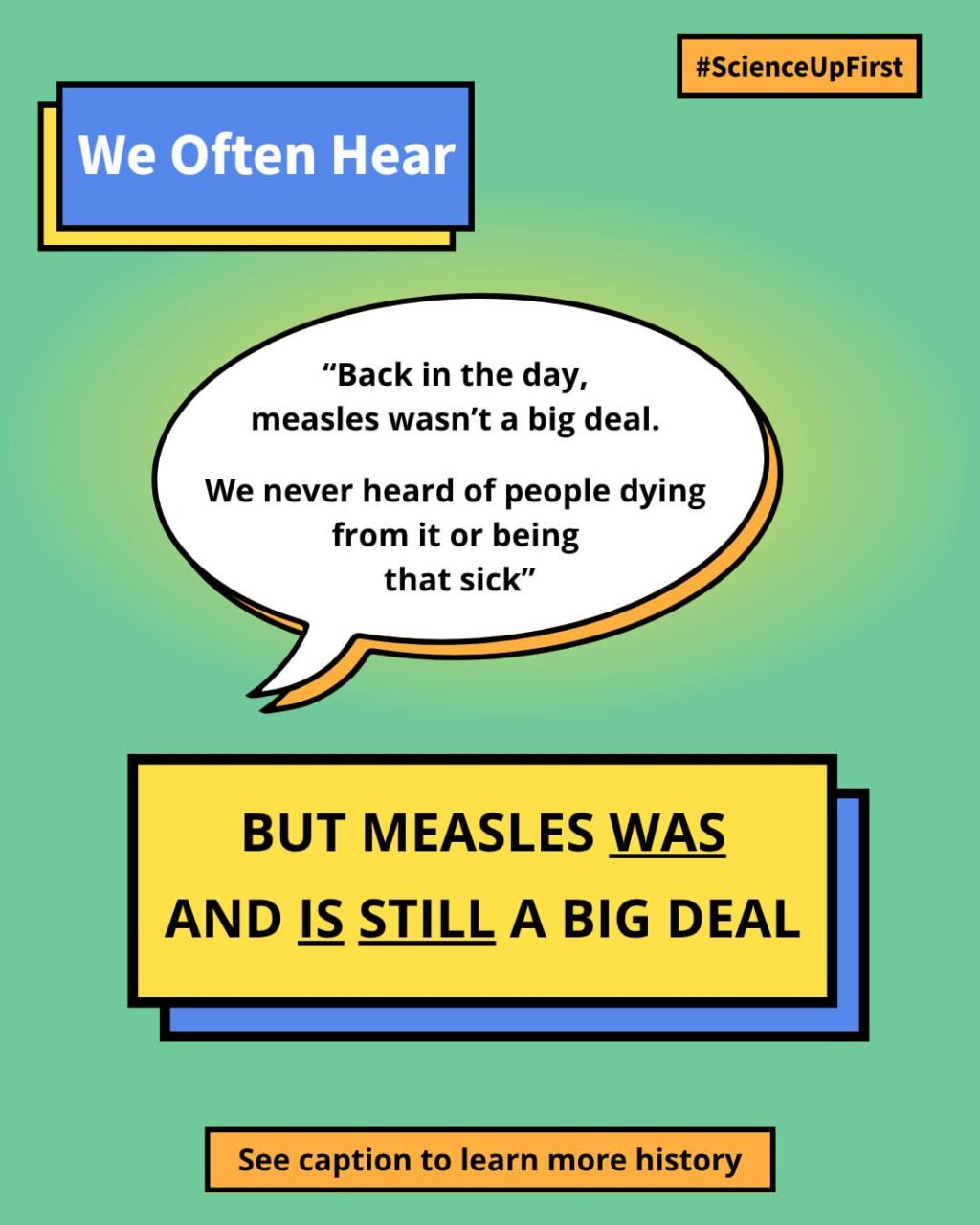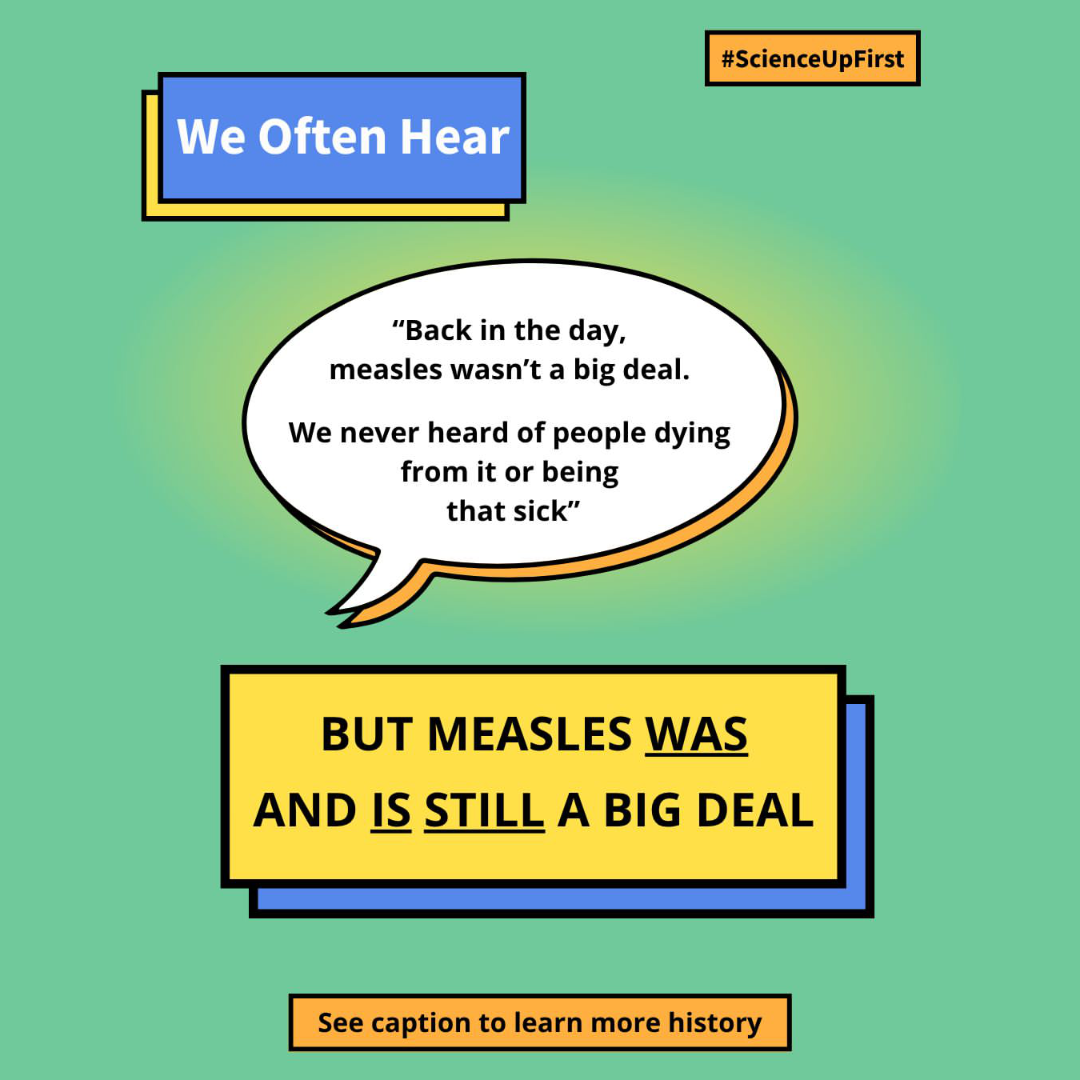
Prior to the introduction of vaccines, there were on average 45,000 measles cases each year in Canada (1-3). Contrary to some claims, measles-related deaths were pretty common in the early 1900s, killing hundreds each year. In 1926, Canada saw its highest death toll ever reported, with nearly 900 deaths (21 deaths per 1,000 cases) (3-6).
While death numbers had declined into the double digits by the late 1950s – largely due to improvements in medical care, nutrition, and living conditions – measles itself remained widespread. Case numbers did not significantly decrease, and annual deaths didn’t drop below 10 until after vaccination began (3,5,7-9).
Although most people survived the infection, measles was not benign and serious complications were still common. About 1 in 10 Canadians developed secondary infections like bronchopneumonia, and roughly 1 in 1,000 developed brain inflammation which can lead to coma, seizures, permanent neurologic damage, and death (5-7,10).
The first measles-containing vaccine was approved in Canada in 1963 and introduced into routine immunization programs across the country early in the 1970s (6). In the decade before routine vaccination, Canada saw an average of 358 cases per 100,000 people. By the early 1990s, that rate had fallen to around 18 per 100,000 – a drop of 95% (3-5,10,11). But because local transmission continued despite one-dose coverage, a second dose was added to routine immunization programs by 1997 to strengthen people’s protection (3,4,6,10,12,13). By 1998, the virus no longer spread locally and cases only appeared when brought in from outside the country (14,15). But cases and deaths remained high worldwide (16). In 2019, only 113 cases were reported in Canada – an incidence rate of just 0.3 per 100,000 people (17).
So while measles wasn’t always fatal, it was far from harmless. It may not have been widely talked about back in the day because deaths had already declined, not because it wasn’t serious. Vaccination made a dramatic difference in both preventing illness and avoiding its serious consequences.
- Guidelines for measles outbreak in Canada | The Public Health Agency of Canada | October 2013
- Measles | National Collaborating Centre for Infectious Diseases | Updated April 2, 2025
- Measles in Canada – 1986 update | Epidemiologic Report – Canadian Medical Association Journal | September 1986
- Measles Elimination in Canada | The Journal of Infectious Diseases | May 2004
- Measles Elimination in the United States | The Journal of Infectious Diseases | May 2004
- Measles: For health professionals | Government of Canada
- The misery of measles in a world without vaccines | The Globe and Mail | February 2015
- History of measles vaccination | World Health Organization
- Age-specific measles mortality during the late 19th–early 20th centuries | Epidemiology & Infection | April 2015
- Impact of Measles in Canada | Reviews of Infectious Diseases | June 1983
- Consensus Conference on Measles | Canada Communicable Disease Report | May 1993
- Canadian National Report on Immunization 1996 | Canada Communicable Disease Report | May 1997
- Supplementary statement on Measles elimination in Canada | National Advisory Committee on Immunization (NACI) – Canada Communicable Disease Report | January 1996
- Measles and Rubella Weekly Monitoring Report | Government of Canada
- Measles | Canada Communicable Disease Report | March 1999
- Global Measles Control and Regional Elimination, 1998-1999. | CDC | December 1999
- Measles surveillance in Canada: 2019 | Canada Communicable Disease Report (CCDR) – The Public Health Agency of Canada | March 2021
Share our original Bluesky Post!
While measles wasn't widely discussed at the time because the number of deaths had already declined, it was still serious. Vaccination has helped prevent the disease and avoid its severe consequences. Read more here 👉 scienceupfirst.com/public-healt… #ScienceUpFirst
— ScienceUpFirst (@scienceupfirst.bsky.social) June 6, 2025 at 3:34 PM
[image or embed]
View our original Instagram Post!




